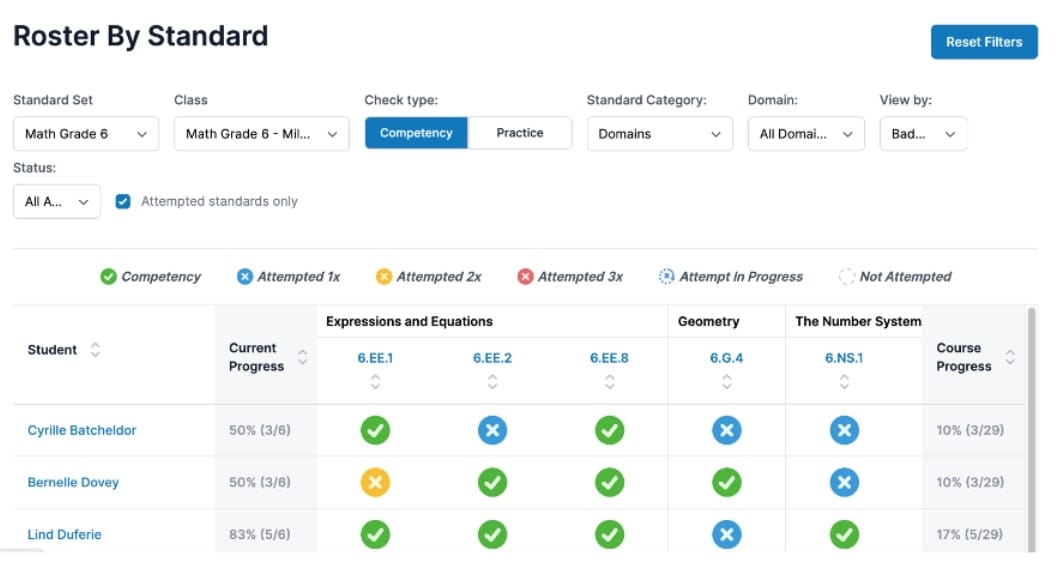North Dakota's A+ Assessment System: An Integrated Approach, Powered by Pearson

"When we understand each assessment's purpose, we unlock the power of personalized instruction, have deeper conversations about student growth, and paint a more complete and accurate picture of achievement."
– Kirsten Baesler, North Dakota State Superintendent of Education
In a classroom in rural North Dakota, a teacher works with students to tackle a math problem. As they work, she's not just observing her students—she's receiving real-time, tech-driven data on their progress, pinpointing exactly where each student excels or struggles. This is a "formative" assessment, and together with "interim" and "summative" assessments, provides a holistic view of student performance; the goal of North Dakota's revolutionary A+ Assessment System, and the vision--realized--of State Superintendent of Education, Kirsten Baesler.
Like so many educators across the country, North Dakota educators grappled with student assessments that provided valuable, but often fragmented, data. New Pearson research in partnership with K12 Dive reveals that seven out of ten K-12 leaders and educators say it’s “very important” to be able to easily access assessment results and to measure students’ progress toward learning targets, but less than 50% strongly agree they have such capabilities. Driven by this awareness, Baesler set out to create an assessment system that was integrated, comprehensive, and with more timely, practical insights. Simply put, better and more effective for students and teachers.
A challenge, and a vision for comprehensive assessment
Baesler's journey to reshape K-12 assessment in North Dakota began with a clear recognition of the existing system's shortcomings. The previous approach, which often relied on isolated summative assessments, failed to provide a continuous and linked narrative of student learning. Baesler explained, "if you don't give teachers and families (and students themselves) the right tools and the right feedback along the way, their ability to impact outcomes is more limited."
She shared stories of educators and parents working tirelessly with students, believing students were on track, only to see disappointing end-of-year results that didn't align to the supposed student progress reported with other measurement tools throughout the year. Baesler wanted an assessment system that not only evaluated student proficiency at the end of the year but also provided ongoing, rigorous insights throughout the school year.
"The key was that the assessments needed to build off of each other and be connected to better understand the learning of our students," Baesler explained. This "non-negotiable" drove the development of the North Dakota A+ system, integrating formative, interim, and summative assessments to offer a cohesive and thorough understanding of student progress.
The Three Pillars of North Dakota A+
The North Dakota A+ system is built on three key components, each serving a distinct yet interconnected purpose:
- Formative Assessments: Evaluations administered close to the point of instruction, providing immediate, actionable data for real-time adjustments within the classroom.
- Interim Assessments: Periodic checkpoints throughout the school year to monitor student growth and progress toward year-end objectives to drive bigger strategic instructional decisions.
- Summative Assessments: Assessments given at the end of the school year, offering a comprehensive view of overall learning outcomes and achievement.
By integrating all these assessments into one A+ system, Baesler's goal is delivered: each data point works together to provide a full, more nuanced, narrative of student performance.
Further, A+ moves North Dakota toward the "balanced assessment system" recommended by the National Research Council. In its Knowing What Students Know: The Science and Design of Educational Assessment, it states that balanced assessment systems include clear alignment of assessments with learning targets (like North Dakota's Content Standards and Achievement Descriptors), diverse evidence gathering through multiple assessments (three ND standards-aligned assessments at different levels of detail), and ongoing tracking of student progress.1
Stanley Schauer, North Dakota Director of Assessment, reinforced the collaborative touch points involved in the new assessment system. “Teachers played an instrumental role developing state standards and achievement levels. To see these efforts in action in our assessment system is exactly what was intended. It is very rewarding.”
Navvy: the "Crown Jewel" of A+
At the heart of the North Dakota A+ system lies Pearson's Navvy, a formative assessment tool aligned to state standards that Baesler refers to as the "crown jewel" of their assessment system. Navvy places student data directly in teachers' hands, allowing for immediate use in the classroom.
Navvy's standard-by-standard assessments can be assigned by teachers as needed, offering detailed insights into student progress on specific standards. The tool's teacher dashboard allows for immediate progress monitoring and the creation of individualized learning profiles for each student.

Stakeholder Engagement and Implementation
Implementing the A+ system required extensive collaboration with educators, administrators, and community members to ensure the system met their needs and expectations. Professional development initiatives were crucial, as improving assessment literacy among teachers, principals, and school board members was essential for the system's success.
North Dakota Department of Public Instruction has a two-person assessment office, but the partnership with Pearson has made it possible to scale a statewide implementation and training effort to support every district and school in the implementation of North Dakota A+. Assistant Director Kara Welk and Pearson team members provide in-person and virtual meetings, training, and coaching sessions to assist by meeting administrators and teachers where they are - both in physical location and level of assessment knowledge.
Baesler reiterated the significance of teacher buy-in. "Psychometricians and state leaders can get caught up in the big picture. We need to get on the dance floor, we need to find out what our teachers want. And what they want is a through-year approach that ties what they're doing every day in their classroom to the summative tests in the spring. Without teacher support, we will go back to the day of teachers saying, oh, that assessment doesn't matter."
Looking Ahead
As North Dakota continues to refine and expand its A+ assessment system, early successes are promising. Educators now have access to timely, specific, and accurate information that supports personalized learning. Baesler's vision for the future includes leveraging technology to further enhance the assessment process and continuing to focus on student outcomes.
"I'm very excited about what the future holds. Supported by technology and more granular insights, we will become more laser focused on student outcomes. It is the reason we exist--to provide the best education possible for North Dakota students."
1 Marion, S. F., Pellegrino, J. W., & Berman, A. I. (Eds.). (2024). Reimagining Balanced Assessment Systems. National Academy of Education.
